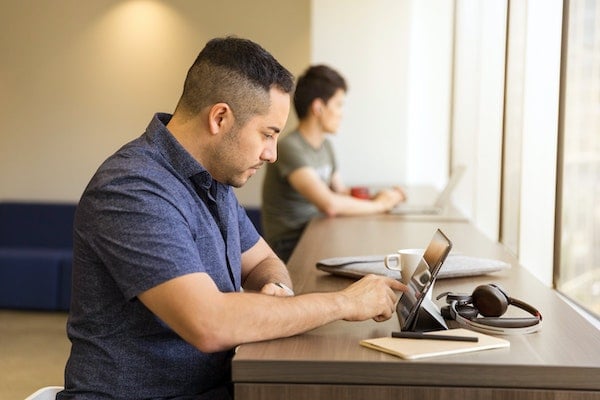Published on
Adjusting to the Reality of Remote Learning

In the wake of the COVID-19 pandemic, colleges and universities across North America have moved their face-to-face courses and programs online with lightning speed. This transition to remote learning has allowed learners to finish out their semesters, stay on track with their degrees and retain a semblance of normality in an abnormal time. In this interview, Laurie Borowicz reflects on how the shift to this new model has impacted faculty, staff and learners and shares her insights into the import role community plays in adjusting to crisis.
The EvoLLLution (Evo): How has Kishwaukee College responded to the COVID-19 outbreak?
Laurie Borowicz (LB): We drafted a temporary plan when things were first starting to unfold here in Illinois and specifically in the Chicago area. It was supposed to get us to Easter; it lasted for a day. Then, we had a conference call with the governor’s office and got more information about what was going on and how it was spreading. My leadership team got together the next day, I told them that we were being encouraged to go online, and we discussed how to move forward. The assistant vice president of instruction suggested we remain online for the rest of the semester, and we were the second of Illinois’ 48 schools to make that decision. It was a good call because our faculty and staff were able to focus on the long-term.
Evo: How have learners in workforce and career education programs been affected by the shift to remote education?
LB: It’s a bigger challenge for career and technical education courses because they’re more focused on hands-on learning. I’ve been impressed with how faculty are embracing tools designed to teach remotely and virtually. They’re working hard to creatively come up with solutions and answers. Of course, we’re still trying to figure out how we’re going to measure competencies. It’s encouraging to see faculty embrace the change and come up with new solutions. There’s a spark of energy. We allotted a week for staff and faculty to figure this new normal out. The positive energy was really heartwarming, seeing how people were working together to find solutions. We just purchased some virtual clinical simulation software for our nursing program, which has drawn people together. All told, this has really made people get creative in how we address what’s going on. Towards the end of the semester, we’re hoping to get some students back on campus to test the skills that they’re learning remotely.
Evo: What has the operational shift to remote learning been like?
LB: When I first arrived at Kish in 2016, it had a declining enrollment for the last five years, and the core issues weren’t being addressed. The college never really changed its processes. There was a significant focus on autonomy, but unfortunately it led to people not rowing the boat together.
We also did very little online instruction at that time and had no fully online degree programs. About two years ago, we were approved by HLC to launch a fully accredited online program, and we’ve taken off from there. Last year, 20% of our enrollments were online. We had definitely already been making this shift into a more virtual world.
We created a full-time position whose role is to support faculty with Quality Matters best practices and help them embrace online instruction. We also created a complementary IT position to support the technical needs of online instructors and faculty. We had the process and systems in place, and every course had the shell. We also had a faculty-led online learning community, which has been pretty active over the last couple years.
So, we had the structure in place to support a shift to remote learning. It’s been heartwarming to see folks across the college embrace change rather than refuse it. We were well positioned to do this, so people are starting to feel that they can adapt to the new normal.
Evo: How are staff and faculty adapting to this new normal?
LB: If you have the structure and the process in place, changes will inflict minimal pain.
For staff, we implemented a lot of technology. This was when we started to have to decline in IT staff and student services, back when we had the budget crisis. So, we have a lot of online support and technical support to help people do their jobs remotely. It feels good that we can continue to provide all of our services—whether it’s advising, enrolling, library services or tutoring—in an online environment. It allowed us to easily roll everything out as we’ve moved forward.
COVID-19 arrived like a tsunami, and we are going to figure it out. Do I think we’re doing everything wonderfully in the virtual classrooms? No, I know we’re not going to have that all figured out this spring, but it gave us a great jumping-off point. We’ve been doing a lot of virtual meetings through tools like Zoom. That terminology “new normal” is really important here. We’re not going to return to the status quo after this—there will be a new normal.
I have a high school child who’s now doing eLearning and is getting ready to look at applying to colleges. Trust me, they are going to look at college differently now that they’re becoming comfortable learning online.
Evo: How concerned are you that with the shift to remote learning, people will equate the experience with what’s possible in a truly well-designed online environment?
LB: We continue to have those conversations about quality. I’m hoping people will continue to take feedback from their students and be open to suggestions and opportunities. They have to create their own culture and learn best practices from each other.
When we hired our QM person to help support faculty with online learning, he already a faculty member. He was very adamant that this new position would remain a faculty position because he felt like it needed to be peer-to-peer.
As leaders, we need continue to support and encourage peer-to-peer mentoring to achieve and retain quality. It cannot be top-down mandated, and I hope some of it comes from our students.
We also want to create a community of CTE instructors to get best practices of online instruction for career and technical education. We’re going to have to figure out how to incentivize, support and promote this idea of them growing online learning in their departments and in their world. It’s an exciting challenge.
Evo: What surprised you the most about how the shift has gone?
LB: Nothing major has surprised me about this shift. It’s been heartwarming to see that even though we can have differences and disagreements, when a crisis arises, we can rally together and be there for our students.
Ultimately, we’re here for our students, and we’re doing this for our students.
Evo: What are a few lessons about disaster preparedness that you’ve taken from this experience so far?
LB: It’s not about having the best plan on the shelf and using it to get through crises. It’s about your people and how they understand their roles.
Having a team and environment that understand the necessity of working together is essential. When something like this happens, you don’t have time for debate. Adapting to something like this has to be an innate part of your culture. I’m fortunate to have the team I have.
We have no silos, we work together, and whatever the crisis at hand, we can weather it.
This interview was edited for length and clarity.
Editor’s note: This interview was recorded on March 25, 2020.
Author Perspective: Administrator



